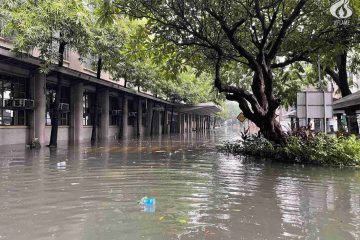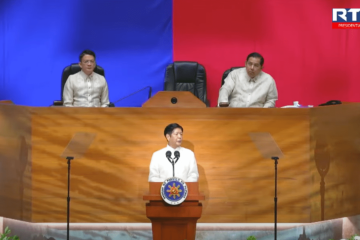
A NUMBER of student society leaders from the Faculty of Arts and Letters (AB) want their programs to implement limited face-to-face classes, saying their disciplines require personal interaction and access to the library.
Society representatives interviewed by The Flame said some courses in their respective programs are best suited for in-person learning.
“There are courses in our program that require hands-on teaching like TV Production. You cannot learn how to produce or do a TV production with just online devices,” Martin Alcantara, President of the UST Communication Arts Student Association (CASA), said.
Alcantara added that the University is “lagging behind” in terms of conducting face-to-face classes, which he sees as more effective than the current virtual learning setup.
Sociological Society president Kalea Adrienne Aquino said limited in-person classes are necessary for courses that require community interaction.
“We often do community work outside the school. So, I think it’s really essential for us because community work is hard to do online,” Aquino said.
Behavioral Science Society external vice president Timothy Coronel echoed this, saying his course “focuses heavily on in-person interaction.”
“If we are to continue the virtual learning set-up for these, the competencies that need to be enhanced will not be as developed as we wish because it is not done in person,” Coronel said.
MaKatha Circle president Marie Claire Lagrisola is also in favor of resuming in-person classes, saying creative writing students need access to books and documents that are only available in the UST Miguel de Benavides Library.
“We undergo workshops and our revisions cannot be immediately and effectively attended to via online remedies, consequently cutting short the potential of literary discussions and disrupting craft improvement,” Lagrisola said.
The University adopted the enhanced virtual mode of instruction in 2020 to ensure the safety of students and teaching staff from COVID-19. However, some students have complained about the difficulties that come with the online set-up including the unstable internet connection and increased workload.
Last month, AB Dean Marilu Madrunio told The Flame that the faculty is preparing to request limited on-site classes for two journalism courses, namely broadcast and photojournalism, for the next academic year. The inclusion of other AB programs in the limited face-to-face classes would depend on the result of the journalism program’s proposal, she added.
Despite the decreasing COVID-19 case rates and the easing of mobility restrictions, Vice-Rector for Academic Affairs Prof. Cheryl Peralta told The Flame last month that the University has no plans to resume in-person classes for all programs this term.
Unlike his counterparts from other courses, Literary Society president Jenric Jose sees no need to include his program in the expanded face-to-face classes, citing “practical reasons” like safety and the cost of attending on-campus classes.
“From the perspective of my course and society, it’s a justifiable decision as we are not overly reliant on face-to-face. However, some majors do have subjects that require hands-on/on-site training so it might be best to consider those courses as well,” Jose said.
Jose said the literature program remains open to decision changes, depending on the pandemic situation in Metro Manila.
UST Journalism Society president Marymon Reyes thinks the conduct of limited onsite classes strikes a balance between the concerns of students who have issues about the online set-up and guardians who have safety concerns.
“I hope that anytime soon will all programs have the opportunity to go back to face-to-face classes, for we all know that not all EVM (enhanced virtual mode) delivered at home are effective or efficient for our students,” Reyes told The Flame.
Reyes said the journalism program is considering a number of factors like the demographics of students living in areas far from the University, adjustments related to their transfer from St. Raymund de Peñafort to the Buenaventura Garcia Paredes, O.P. building, and the enforcement of health protocols.
Last month, the UST Office of the Secretary-General said the further expansion of onsite classes would be subject to the approval of the University Crisis Management Committee.
The government has placed Metro Manila under the most lenient Alert Level 1 until April 15. Under the classification, schools may conduct in-person classes at full capacity. F – Aubrey Shane R. Lim and Katherine K. Chan



